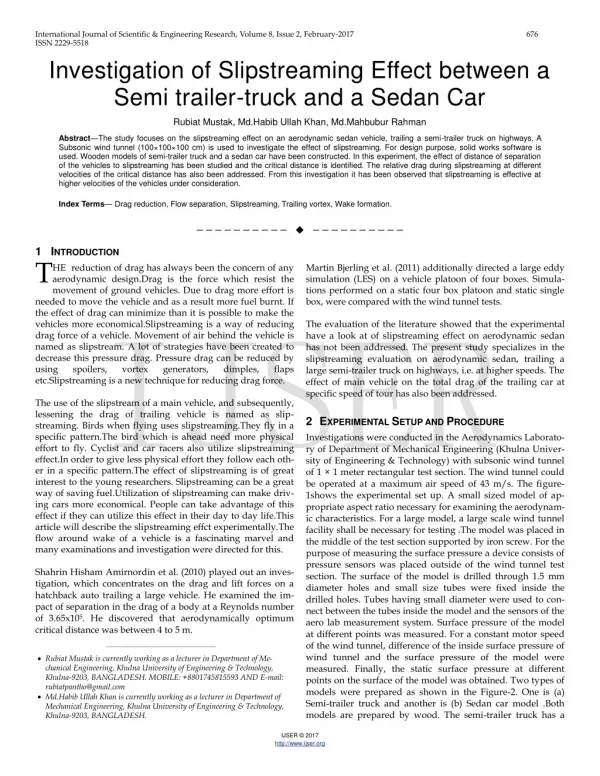Investigation of Slipstreaming Effect between a Semi trailer-truck and a Sedan Car
Abstract—The study focuses on the slipstreaming effect on an aerodynamic sedan vehicle, trailing a semi-trailer truck on highways. A Subsonic wind tunnel (100×100×100 cm) is used to investigate the effect of slipstreaming. For design purpose, solid works software is used. Wooden models of semi-trailer truck and a sedan car have been constructed. In this experiment, the effect of distance of separation of the vehicles to slipstreaming has been studied and the critical distance is identified. The relative drag during slipstreaming at different velocities of the critical distance has also been addressed. From this investigation it has been observed that slipstreaming is effective at higher velocities of the vehicles under consideration. Index Terms— Drag reduction, Flow separation, Slipstreaming, Trailing vortex, Wake formation. 1 INTRODUCTION The reduction of drag has always been the concern of any aerodynamic design.Drag is the force which resist the movement of ground vehicles. Due to drag more effort is needed to move the vehicle and as a result more fuel burnt. If the effect of drag can minimize than it is possible to make the vehicles more economical.Slipstreaming is a way of reducing drag force of a vehicle. Movement of air behind the vehicle is named as slipstream. A lot of strategies have been created to decrease this pressure drag. Pressure drag can be reduced by using spoilers, vortex generators, dimples, flaps etc.Slipstreaming is a new technique for reducing drag force. The use of the slipstream of a main vehicle, and subsequently, lessening the drag of trailing vehicle is named as slip-streaming. Birds when flying uses slipstreaming.They fly in a specific pattern.The bird which is ahead need more physical effort to fly. Cyclist and car racers also utilize slipstreaming effect.In order to give less physical effort they follow each other in a specific pattern.The effect of slipstreaming is of great interest to the young researchers. Slipstreaming can be a great way of saving fuel.Utilization of slipstreaming can make driving cars more economical. People can take advantage of this effect if they can utilize this effect in their day to day life.This article will describe the slipstreaming effct experimentally.The flow around wake of a vehicle is a fascinating marvel and many examinations and investigation were directed for this. Shahrin Hisham Amirnordin et al. (2010) played out an investigation, which concentrates on the drag and lift forces on a hatchback auto trailing a large vehicle. He examined the impact of separation in the drag of a body at a Reynolds number of 3.65x105. He discovered that aerodynamically optimum critical distance was between 4 to 5 m. Martin Bjerling et al. (2011) additionally directed a large eddy simulation (LES) on a vehicle platoon of four boxes. Simulations performed on a static four box platoon and static single box, were compared with the wind tunnel tests. The evaluation of the literature showed that the experimental have a look at of slipstreaming effect on aerodynamic sedan has not been addressed. The present study specializes in the slipstreaming evaluation on aerodynamic sedan, trailing a large semi-trailer truck on highways, i.e. at higher speeds. The effect of main vehicle on the total drag of the trailing car at specific speed of tour has also been addressed. 2 EXPERIMENTAL SETUP AND PROCEDURE Investigations were conducted in the Aerodynamics Laboratory of Department of Mechanical Engineering (Khulna Univer-sity of Engineering & Technology) with subsonic wind tunnel of 1 × 1 meter rectangular test section. The wind tunnel could be operated at a maximum air speed of 43 m/s. The figure-1shows the experimental set up. A small sized model of ap-propriate aspect ratio necessary for examining the aerodynamic characteristics. For a large model, a large scale wind tunnel facility shall be necessary for testing .The model was placed in the middle of the test section supported by iron screw. For the purpose of measuring the surface pressure a device consists of pressure sensors was placed outside of the wind tunnel test section. The surface of the model is drilled through 1.5 mm diameter holes and small size tubes were fixed inside the drilled holes. Tubes having small diameter were used to connect between the tubes inside the model and the sensors of the aero lab measurement system. Surface pressure of the model at different points was measured. For a constant motor speed of the wind tunnel, difference of the inside surface pressure of wind tunnel and the surface pressure of the model were measured. Finally, the static surface pressure at different points on the surface of the model was obtained. Two types of models were prepared as shown in the Figure-2. One is (a) Semi-trailer truck and another is (b) Sedan car model .Both models are prepared by wood. The semi-trailer truck has a length of 38cm, width of 8.60 cm and height of 10.6cm.The constructed sedan car has a length of 12.5 cm, width of 5 cm and height of 4 cm.The experimental setup is shown in Fig.1. 3 RESULTS AND DISCUSSION The semi-trailer vehicle is located far away of 15cm down-stream the inlet of the wind tunnel.For experimentation the semi trailer truck is trailed by the sedan car.The length between car and semi-trailer pickup truck is then assorted from 4cm to 28cm. The wind tunnel analysis was conducted at three rates of speed. The speed which were considered for the experimentation respectively 80kmph (22.22 m/s), 100kmph (27.77m/s) and 120kmph (33.33 m/s). When air flows over the car drag forces will develop in the front and back side of the car and the resultant of these forces is the net drag. The worthiness of net drag force with distance between vehicles has been obtained at the three velocities and the mandatory graph has been plotted. By experimentation the position of minimum drag has been identified. With the help of obtained data a graph is plotted which is shown in fig-3. From fig-3 it is observed that as distance boosts from 4cm to 12cm, the pull force rises. But distance which is more than 12cm the drag on the automobile started to diminish. After 12cm distance the vortex which strikes at the front end of the automobile changes course. At distances significantly less than 12cm, vortex in front of the car rotate counter-top clockwise. After 12cm the course of vortex just before the automobile changes from anti-clockwise to clockwise. This reduces drag or is named beneficial slipstreaming. Though slipstreaming is effective at a distance more than 12 cm but it has negative effect after a distance of 20cm. At distance more than 20 cm the clockwise rotation of vortex does not favour the automobile. As the slipstreaming does not favour the automobile, as a result of this the drag force again starts off increasing. From the typical Fig-3, it could be seen that lowest pull occurs at 4cm. But safety is not enough in such small distance.Considering the factor of safety it is not taken as the optimum slipstreaming distance. As a result the distance of 20cm between vehicles which corresponds to second least drag is taken as optimum point. Several readings were taken at distance of 20 cm with the variation of speeds.From figure 4 it is seen that more speeds result in more drag forces.At velocity of 120 kmph the drag force is maximum for both case of slipstreaming and without slipstreaming .But the better slip streaming result is obtained at a velocity of 120 kmph.Which verifies that slipstreaming is effective at higher velocities. 4 CONCLUSION Although predicated on the exploration performed, it's been established that slipstreaming works well at higher velocities of the ve-hicles in mind.Slipstreaming can be used for reducing physical effort and consumption of fuel. There is a critical distance which is sutable for driving. This critical distance was discovered and by experimentation it is found as the swiftness escalates the magnitude of drag reduction heightens at critical distance. At critical distance there exists maximum of 83.67% reduced amount of drag. In the results obtained and taking into account the useful circumstance, it is concluded that a distance of 20cm between vehicles is most effective.By maintaining this distance it is possible to reduce the fuel consumption while driving cars and physical effort while considering bi-cycle racing. ACKNOWLEDGMENT My sincere acknowledgments to Dr. Mohammad Mashud, Professor of the Department of Mechanical Engineering of Khulna University of Engineering & Technology (KUET) for his support and guidance. REFERENCES [1] Shahrin Hisham Amirnordin et al..,“Numerical Analysis on the Effects of Air Flow in the Wake of a Large Vehicle on Trailing a Passenger Car”, Proceedings of MUCET 2010. [2] Martin Bjerling, “Large Eddy Simulations on a Vehicle Platoon During In- Line Oscillations”, Bachelor’s thesis 2011:37, Chalmers University Of Technology Gothenburg, Sweden 2011. [3] Han T., “Computational analysis of three dimensional turbulent flow around a bluff body in ground proximity”, AIAA Journal, Volume 27, Issue 9,Pages 1213- 1219. [4] Ahmed S.R. “Wake structure of typical automobile shapes”, Trans. ASME, J. Fluids Eng. Volume 103, Pages 162-169. [5] Prof.Simon Watkins, Kevin Stark “Slipstreaming Reduces Drag in Horse Racing up to 66 Percent”, Canadian Horse Journal, June 2015 issue.
★
★
★
★
★
50 views • 3 slides




